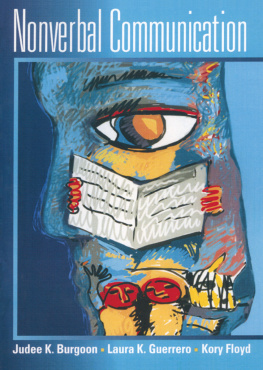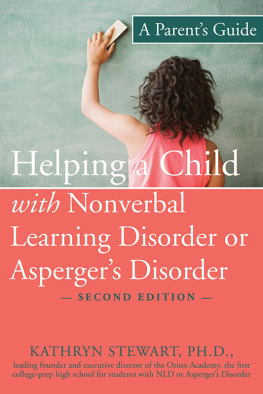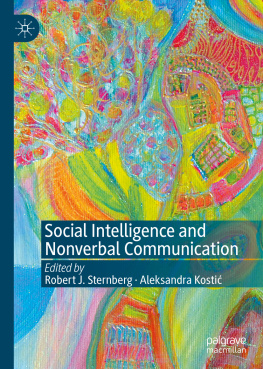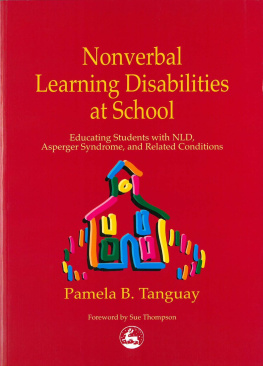Judee K Burgoon - Nonverbal Communication
Here you can read online Judee K Burgoon - Nonverbal Communication full text of the book (entire story) in english for free. Download pdf and epub, get meaning, cover and reviews about this ebook. year: 2009, publisher: Routledge, genre: Romance novel. Description of the work, (preface) as well as reviews are available. Best literature library LitArk.com created for fans of good reading and offers a wide selection of genres:
Romance novel
Science fiction
Adventure
Detective
Science
History
Home and family
Prose
Art
Politics
Computer
Non-fiction
Religion
Business
Children
Humor
Choose a favorite category and find really read worthwhile books. Enjoy immersion in the world of imagination, feel the emotions of the characters or learn something new for yourself, make an fascinating discovery.
- Book:Nonverbal Communication
- Author:
- Publisher:Routledge
- Genre:
- Year:2009
- Rating:3 / 5
- Favourites:Add to favourites
- Your mark:
- 60
- 1
- 2
- 3
- 4
- 5
Nonverbal Communication: summary, description and annotation
We offer to read an annotation, description, summary or preface (depends on what the author of the book "Nonverbal Communication" wrote himself). If you haven't found the necessary information about the book — write in the comments, we will try to find it.
Drawing significantly on both classic and contemporary research, Nonverbal Communication speaks to todays students with modern examples that illustrate nonverbal communication in their lived experiences.
This new edition, authored by three of the foremost scholars in nonverbal communication, builds on the approach pioneered by Burgoon, Buller and Woodall which focused on both the features and the functions that comprise the nonverbal signaling system. Grounded in the latest multidisciplinary research and theory, Nonverbal Communication strives to remain very practical, providing both information and application to aid in comprehension.
Nonverbal Communication — read online for free the complete book (whole text) full work
Below is the text of the book, divided by pages. System saving the place of the last page read, allows you to conveniently read the book "Nonverbal Communication" online for free, without having to search again every time where you left off. Put a bookmark, and you can go to the page where you finished reading at any time.
Font size:
Interval:
Bookmark:

Nonverbal Communication
Judee K. Burgoon
University of Arizona
Laura K. Guerrero
Arizona State University
Kory Floyd
Arizona State University

First published 2010 by Pearson Education, Inc.
Published 2016 by Routledge
2 Park Square, Milton Park, Abingdon, Oxon OX14 4RN
711 Third Avenue, New York, NY 10017, USA
Routledge is an imprint of the Taylor & Francis Group, an informa business
Copyright 2010 Taylor & Francis. All rights reserved.
All rights reserved. No part of this book may be reprinted or reproduced or utilised in any form or by any electronic, mechanical, or other means, now known or hereafter invented, including photocopying and recording, or in any information storage or retri eval system, without permission in writing from the publishers.
Notice:
Product or corporate names may be trademarks or registered trademarks, and are used only for identification and explanation without intent to infringe.
Credits and acknowledgments borrowed from other sources and reproduced, with permission, in this textbook appear on appropriate page within text.
ISBN: 9780205525003 (pbk)
Cover Designer: Bruce Kenselaar
Library of Congress Cataloging-in-Publication Data
Burgoon, Judee K.
Nonverbal communication / Judee K. Burgoon, Laura K. Guerrero, Kory Floyd.
p. cm.
Includes bibliographical references and index.
ISBN 978-0-205-52500-3 (pbk.)
1. Body language. 2. Nonverbal communication. I. Guerrero, Laura K. II.Floyd, Kory. III. Title.
BF637.N66B86 2010
153.6'9dc22 2009028235
CONTENTS
Communication plays a central role in our lives. In fact, being a skilled communicator enhances ones prospects for sustaining a happy, healthy, and productive life. This isnt just our opinion. A local conciliation court recently reported that, for the 14th year in a row, the most reported problem among troubled marriages is the lack of good communication. Successful relationships are built on a solid foundation of communication skills. Communication is also instrumental to our success or failure in the workplace. Surveys among business leaders, major employers, and employment counselors emphasize the importance of communication skills in acquiring jobs and performing effectively on the job. A study by the Administrative Management Society, for example, found that 80% of managers rated communication skills as among the most important qualifications of prospective employees; 65% also cited interpersonal and leadership skills. Another study involved asking female managers about the strategies or techniques that they credited with helping them reach their current positions. Rated as very or extremely important were communication skills (89%), personal power (78%), and charisma, charm, and social skills (53%). In a study by a college placement service, several hundred alumni reported that communication abilities were more important to their job success than the major subject they studied.
These testimonials probably pale in comparison to the vividness of your own firsthand experiences. What could be more persuasive evidence of the importance of communication than the recollection of butterflies in your stomach when you fretted about what to say on your first date, the flush of pleasure after making a well-received presentation in class, the exhilaration of receiving a job offer after a grueling interview, the satisfaction of winning an argument with your parents, or the sadness of losing a friendship over a silly disagreement? Clearly, communication plays a pivotal role in the significantas well as insignificantmoments in your life, and the nonverbal dimension is a major contributor to the success or failure of communication.
The fascination with nonverbal communication has spawned thousands of legitimate books and articles on the subject. Knowledge about nonverbal communication now springs from such fountainheads as psychology, psychiatry, sociology, anthropology, linguistics, semiotics, and biology, in addition to the field of communication itself. In fact, the unceasing interest in nonverbal communication has created a state of information overload. Trying to make sense of this diverse body of information is no small task, especially given that scholars from different fields approach nonverbal behavior with differing perspectives, assumptions, and methodologies. At the same time, the popularity of body language has spawned a slew of charlatans and self-proclaimed nonverbal experts who purport to read politicians every move like a book. It is our hope that by the time you finish reading this textbook, you will be able to tell fact from fiction and distinguish valid scientific conclusions and complexities from simplified assertions and suppositions that often trivialize the topic.
Our mission in writing this textbook, then, has been to sift through the mountains of literature on the subject and, while attempting to be comprehensive and current, to distill the most valid and valuable information into understandable and usable principles. Because we believe that different disciplines offer unique perspectives and insights, our take on nonverbal communication is integrative and eclectic. In the process, we hope to have escaped the plight of the three blind men trying to describe an elephant, each with only a limited experience of one part of the elephants anatomy.
This does not mean, however, that there is no underlying perspective that unifies our orientation to nonverbal behavior. We believe that nonverbal communication can best be understood according to the functionsthe goals and purposesit serves. This approach, which other scholars have increasingly embraced, was initially introduced in the first version of this textbook, Burgoon and Saines The Unspoken Dialogue (1978). We are indebted to Tom Saine for his role in developing this original approach to nonverbal communication, just as we are indebted to co-authors David Buller and Gill Woodall for amplifying and updating this approach in a second edition, Nonverbal Communication (1996).
In this latest edition, we have made significant changes to the previous volumes. In ). These four chapters examine the structural and normative features of each code before considering how they interrelate with the verbal code in the remaining chapters.
The remaining eight chapters each tackle a different function of nonverbal communication. They answer the question, What can nonverbal communication do for me or to me? We suspect you are far more interested in knowing how to use nonverbal communication to make a good impression on an employer, influence a group, keep a conversation going, interpret a friends emotional expressions, or woo a mate than to know how many different ways people use eye contact or how frequently they touch. Consequently, the second half of this textbook is organized around the communication functions in which nonverbal behavior plays a central role. It covers the various purposes of nonverbal communication that loom largest in peoples communication lives. provides an ideal culmination for this introduction to nonverbal communication, because it covers deception, which is an amalgam of impression management, interaction management, and influence functions.
Beyond our dedication to a functional approach, another feature unifying our perspective on nonverbal communication is our emphasis on scientific knowledge rather than anecdotal experience. This book is dedicated to giving you the most current and comprehensive coverage of theories and research findings related to nonverbal communication and behavior. Many popular books and self-proclaimed experts promise to divulge how you can win friends and influence people. But the truth is, humans cannot be read like a book, and there are as many questions about nonverbal communication as there are answers. The cookbook approach to communication may make its promoters a bundle of money, but it is unlikely to give you surefire guidance on how to craft your own nonverbal messages or interpret those of others. Much of what we know about nonverbal communication is tentative, because new research is daily challenging or disconfirming old beliefs while creating new ones. The best we can offer you, then, is the latest thinking and scientific evidence that is supplemented rather than replaced by anecdote and personal experience. Although the absence of abundant clear-cut prescriptions about how to behave nonverbally may be unsatisfying to some readers, we are comforted by Voltaires statement that doubt is not a very agreeable status but certainty is a ridiculous one.
Next pageFont size:
Interval:
Bookmark:
Similar books «Nonverbal Communication»
Look at similar books to Nonverbal Communication. We have selected literature similar in name and meaning in the hope of providing readers with more options to find new, interesting, not yet read works.
Discussion, reviews of the book Nonverbal Communication and just readers' own opinions. Leave your comments, write what you think about the work, its meaning or the main characters. Specify what exactly you liked and what you didn't like, and why you think so.










